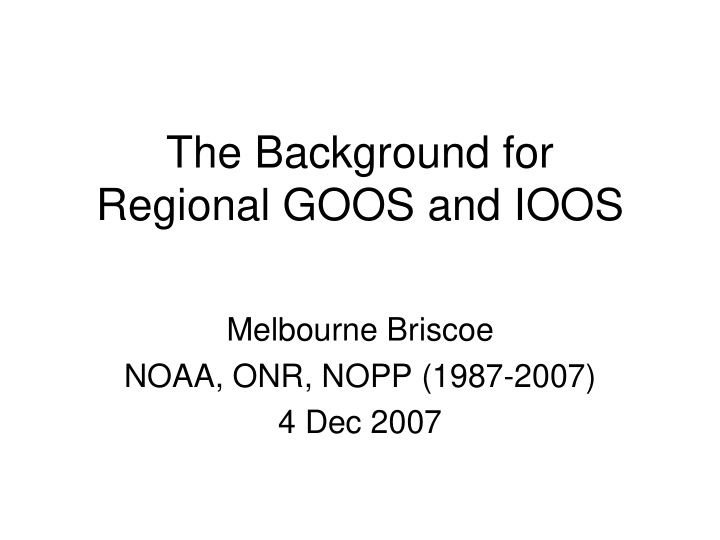



The Background for Regional GOOS and IOOS Melbourne Briscoe NOAA, ONR, NOPP (1987-2007) 4 Dec 2007
Background for Regional Efforts in GOOS and IOOS GOOS • 1988: Jim Baker led an ad hoc group to define a GOOS • 1989-1992: endorsed by IOC, WMO, IPCC, UNCED • 1993: Regional scale concept introduced • 1994-2002: EuroGOOS, NEAR-GOOS, IOCARIBE-GOOS • 2003: first IOCARIBE-GOOS meeting • 2004-2006: IOCARIBE-GOOS represented at GOOS Regional Forum meetings • Now 12 (13) GOOS Regional Alliances
Implementing Coastal GOOS 1st GOOS Regional Forum, Athens, 2-6 December, 2002 2nd GOOS Regional Forum, Nadi, Fiji, 7-9 February 2004 3rd GOOS Regional Forum, Cape Town, 14-17 November 2006
Background for Regional Efforts in GOOS and IOOS IOOS • 1990-1993: U.S. GOOS initiation • 1997: NOPP established by law, center of activity • 1999: Nowlin-Malone, and Frosch reports; IOOS • 2000: Formation of Ocean.US and U.S. subregions • 2002: Airlie House consensus meeting • 2003: NFRA formed; first regional summit • 2005: Implementation Plan based on eleven regions
11 Groups Funded to Establish Regional Associations (RAs) ACOOS GLOS NANOOS NERA CenCOOS MACOORA SCCOOS SECOORA PacIOOS GCOOS CaRA
Why Eleven RA’s? • Nowlin-Malone and Frosch writing teams discussed various governance options to match one Federal government to possibly hundreds of small but interrelated observing systems • Regionalization allowed O(10) [not 1, not 100] consortia to “impedance match” the few Federal agencies to the many local needs and groups • Also, eight LME’s already in place; plus Great Lakes • Nine original strawmen, now stabilized at Eleven
GOOS : A global component, and 12 (13) regional alliances IOOS : a global component, and 11 regional associations • IOOS (= U.S. GOOS) is the U.S. contribution to GOOS • CaRA is the Regional Association of IOOS for CarICOOS, covering the U.S. EEZ in the Caribbean • CarICOOS is the U.S. contribution to IOCARIBE-GOOS (29 Member States and its territories comprising Antigua & Barbuda, Bahamas, Barbados, Belize, Brazil, Colombia, Costa Rica, Cuba, Dominica, Dominican Republic, France, Grenade, Guatemala, Guyana, Haiti, Honduras, Jamaica, Mexico, the Netherlands, Nicaragua, Panama, St. Kitts & Nevis, St. Lucia, St. Vincent & the Grenadines, Suriname, Trinidad & Tobago, United Kingdom, United States of America and Venezuela) ( Steering Committee )
Role of CaRA in IOOS • Cover the U.S. EEZ for PR, USVI – National Backbone scale (coarse, fiducial sites) – Intensive scale (specific local needs, research) • Interface to other Caribbean partners to cover IOCARIBE-GOOS • Other?
- END -
Coastal Backbone Core Variables • Geophysical • Chemical � Sea surface � pCO 2 meteorological � Dissolved inorganic variables nutrients � Land–Sea Stream � Contaminants flows � Dissolved oxygen � Sea level • Biological � Surface waves, currents � Fish species, � Ice distribution abundance � Temperature, Salinity � Zooplankton species, � Bathymetry abundance � Phytoplankton species, • Biophysical biomass (ocean color) � Optical properties � Waterborne pathogens � Benthic habitats
National Backbone Coastal Component • Federal Agencies Responsible Regional COOSs • EEZ & Great Lakes • Core variables required by • Regional Associations regions & Federal Agencies Responsible • Network of sentinel & • Involve private & public reference stations sectors • Standards/Protocols • Inform Federal Agencies of user needs • Enhance the backbone based on user needs • Incorporate sub–regional systems
Example of In Situ Elements of the NB with Regional Enhancements IOOS Elements 7 Enhancements 5 Regional 8 NERA 9 6 1 Backbone National 2 MACOORA 3 4
Recommend
More recommend